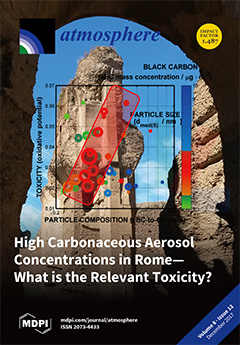A field campaign was performed simultaneously at five measurement sites, having different characteristics, to characterize the spatial distribution of the carbonaceous content in atmospheric aerosol in Southern Italy during the winter season. Organic carbon (OC) and elemental carbon (EC) were measured at urban (Naples), suburban (Lecce), coastal/marine (Lamezia Terme and Capo Granitola), and remote (Monte Curcio) locations. OC and EC mass concentrations were quantified by the thermal-optical transmission (TOT) method, in 24-h PM
10 and PM
2.5 samples collected on quartz fiber filters, from 25 November 2015 to 1 January 2016. The different sites showed marked differences in the average concentrations of both carbonaceous species. Typically, OC average levels (±standard deviation) were higher at the sites of Naples (12.8 ± 5.1 and 11.8 ± 4.6 μg/m
3) and Lecce (10.7 ± 5.8 and 9.0 ± 4.7 μg/m
3), followed by Lamezia Terme (4.3 ± 2.0 and 4.0 ± 1.9 μg/m
3), Capo Granitola (2.3 ± 1.2 and 1.7 ± 1.1 μg/m
3), and Monte Curcio (0.9 ± 0.3 and 0.9 ± 0.3 μg/m
3) in PM
10 and PM
2.5, respectively. Similarly, EC average levels (±standard deviation) were higher at the urban sites of Naples (2.3 ± 1.1 and 1.8 ± 0.5 μg/m
3) and Lecce (1.5 ± 0.8 and 1.4 ± 0.7 μg/m
3), followed by Lamezia Terme (0.6 ± 0.3 and 0.6 ± 0.3 μg/m
3), Capo Granitola (0.3 ± 0.3 and 0.3 ± 0.2 μg/m
3), and Monte Curcio (0.06 ± 0.04 and 0.05 ± 0.03 μg/m
3) in PM
10 and PM
2.5, respectively. An opposite trend was observed for the OC/EC ratios ranging from 6.4 to 15.9 in PM
10 and from 6.4 to 15.5 in PM
2.5 with lower values in urban sites compared to remote sites. Different OC-EC correlations, 0.36 < R
2 < 0.90, were found in four observation sites. This behavior suggests the contributions of similar sources and common atmospheric processes in both fractions. No correlations were observed between OC and EC at the site of Naples. The average secondary organic carbon (SOC) concentrations, quantified using the minimum OC/EC ratio method, ranged from 0.4 to 7.6 μg/m
3 in PM
10 and from 0.4 to 7.2 μg/m
3 in PM
2.5, accounting from 37 to 59% of total OC in PM
10 and from 40 to 57% in PM
2.5 with higher percentages in the urban and suburban sites of Naples and Lecce.
Full article





